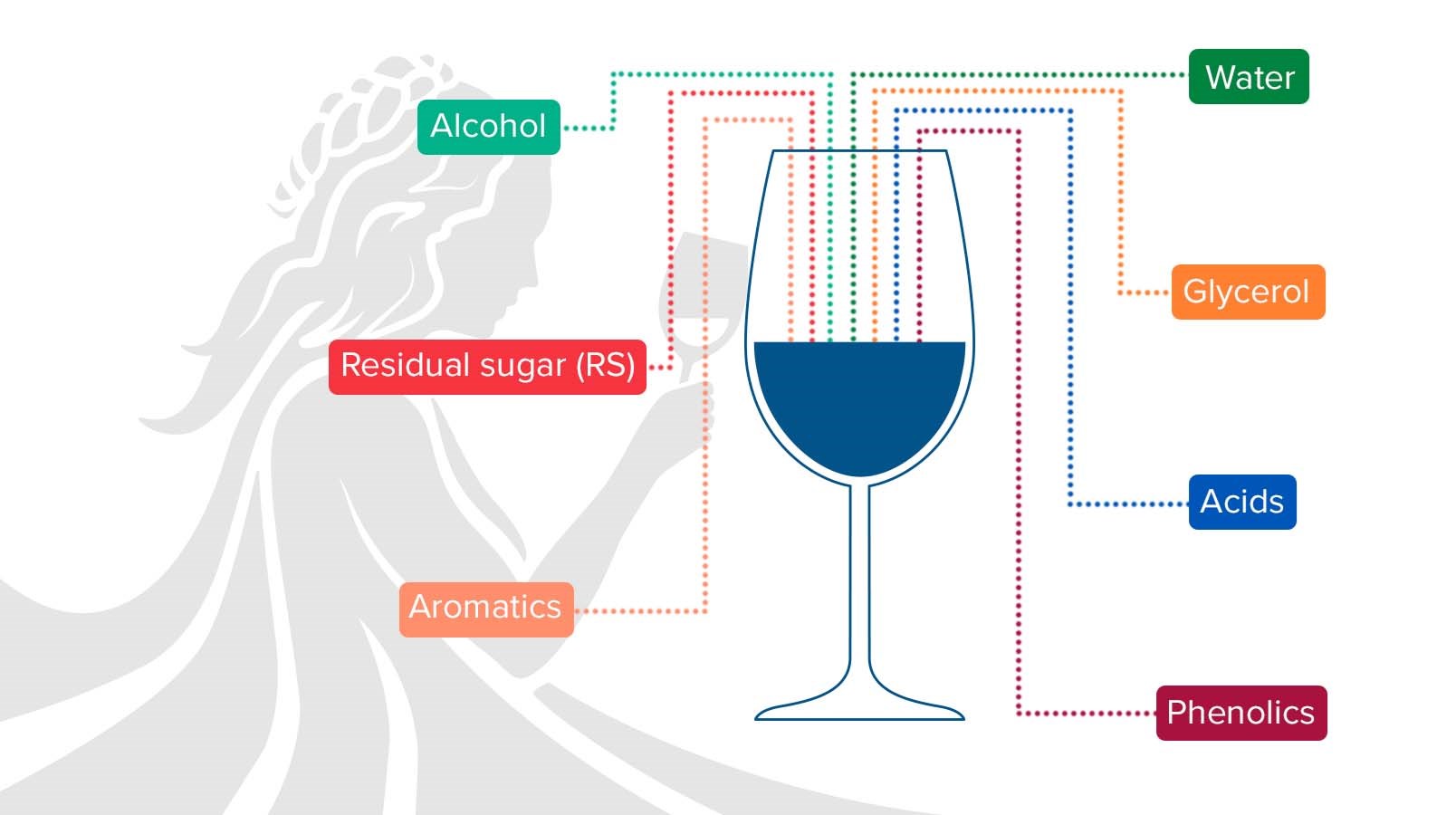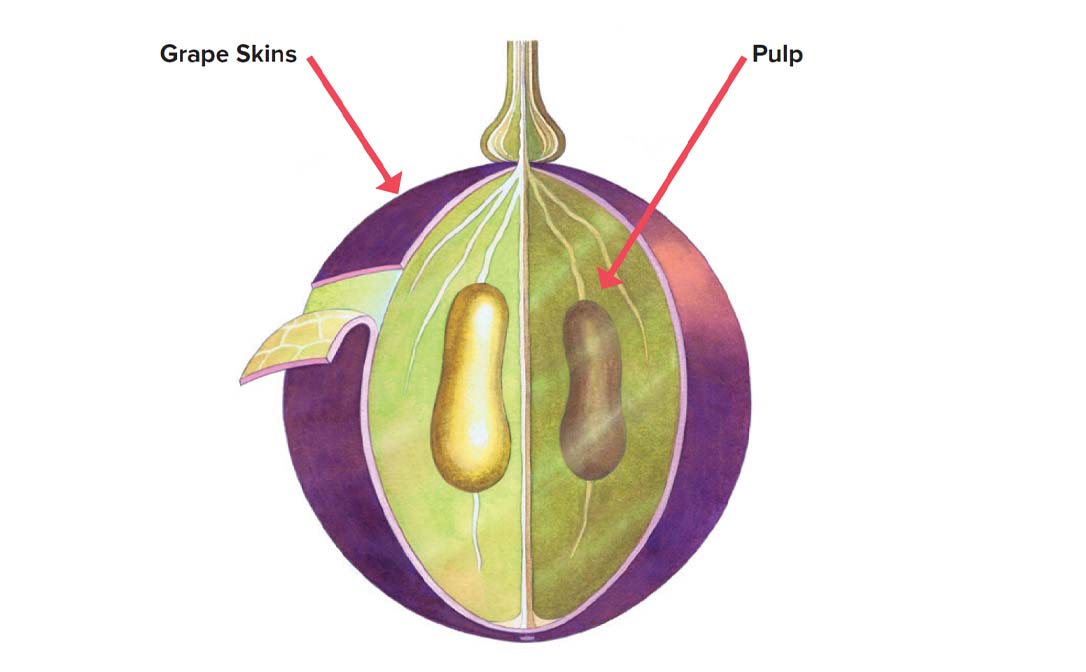Quite simply, wine is fermented grape juice. Grapes are crushed to release their sugary liquid, then alcoholic fermentation changes the grape juice into an alcoholic beverage. But let’s dive a little deeper into the drink itself – what is actually in wine?
With beer, whisky or sake, a complex process is required to create a sugary liquid from the grains used. However, this is not the case with wine – a ripe grape offers a perfect package of raw material for producing a very satisfying alcoholic beverage.
Its pulp largely contains water, sugars and acids, while its skin contains most of the colour, tannin and aroma compounds.
Keen to discover more about the basics of wine characteristics? Our internationally recognised Level 1 Award in Wines will give you the foundation of knowledge to begin your journey in wine. Find out more here.
The finished wine will be made up of a complex combination of compounds, some of which have come directly from the grapes and others formed during fermentation, by the action of yeasts, or other winemaking procedures.
Let’s break these down.
Water
The dominant component in your glass, approximately 85% of the total volume, is water. This percentage can vary depending on the level of alcohol, sugar content and a few other factors. Water is the reason that wine is, well, wet!
Alcohol
Ethanol is the main type of alcohol produced during fermentation – yeasts create ethanol as they process the sugar in the grape juice. The wine alcohol percentage is typically expressed as ‘alcohol by volume’ (abv). In other words, 12% abv means that 12% of the wine is alcohol.
Most wines have alcohols levels of around 8%-15% abv. Fortified wines, where additional alcohol has been added, can range from 15%-22% abv.
As well as being responsible for the intoxication that comes from consuming alcohol, it also contributes body and texture to the wine. Wines with higher levels of alcohol may feel warm on your palate.
Residual sugar (RS)
RS refers to unfermented sugars left over in the wine once the fermentation has come to an end or has been deliberately halted by the winemaker.
Most wines are ‘dry,’ with undetectable levels of RS - usually 2-3 grams per litre (g/L). Off-dry or sweet wines will have much more. For example, Sauternes (a sweet wine from Bordeaux) can have 150 g/L, while Pedro Ximenez sherry can have up to 400 g/L! In addition to making the wine taste sweet, RS can also add body to the wine.
Glycerol
In dry wines, glycerol is the third most abundant component of wine after water and alcohol. It is derived from the sugar in grapes and contributes smoothness and body to the wine.
Acids
Acids are what make your wine taste refreshing. Their presence in the wine makes your mouth water, and they can also play a role in protecting the wine from spoilage.
The principal acids of wine, tartaric acid and malic acid, come from the grape itself. Other acids that are present in the wine, such as lactic or acetic acid, are typically a result of winemaking or maturation processes.
Total acidity in most wines sits in the range of 5.5-8.5g/L.
Aromatics
Although they represent a tiny proportion of the total wine, aromatic compounds (including esters, pyrazines, terpenes, thiols and lactones) are what really make wine interesting!
When we sniff a wine, these compounds are detected by our olfactory system, triggering a response from our brain - this goes a long way to determining whether we enjoy the wine or not!
These compounds can also be found in other plant- and animal-derived products, which is why you are often reminded of herbs, fruits, spices, vegetables or even meats when you put your nose to the glass.
You can read more about wine aromatics and where they come from in our upcoming blog: ‘Why doesn’t wine taste like grapes?’.
Phenolics
Phenolics refers to an important group of compounds in grapes, especially in the skins, stems and seeds. The two that matter most to wine drinkers are:
- Colour pigments (anthocyanins): these are what make red wine red and rosé wine rosé.
- Tannins: these are detected on our palates as a mouth-drying sensation. Depending on their number and nature, they can lend body and a sense of smoothness to the wine, or they may be perceived as bitter.
Other compounds
Your glass of wine will also contain tiny quantities of other compounds, including iron, magnesium and potassium. Some of these can be traced back to the grapes or the yeast, while others may be derived from materials or additives used in the winemaking process, such as clarifying agents and preservatives.
The proportions of all the different components in your glass can differ a great deal from wine to wine. The grape variety/ies used, natural factors (such as soil, climate, weather etc.) and human influences in grape growing, winemaking and maturation, all have a role to play in making every wine unique.
Interested in learning more about the factors that affect wine style and quality? Then our Level 2 Award in Wines is perfect for you. Hit the link here to find out more.
Written by Lucy Stevenson DipWSET DipIDM, Regional Marketing Manager - EMEA
Related content:




